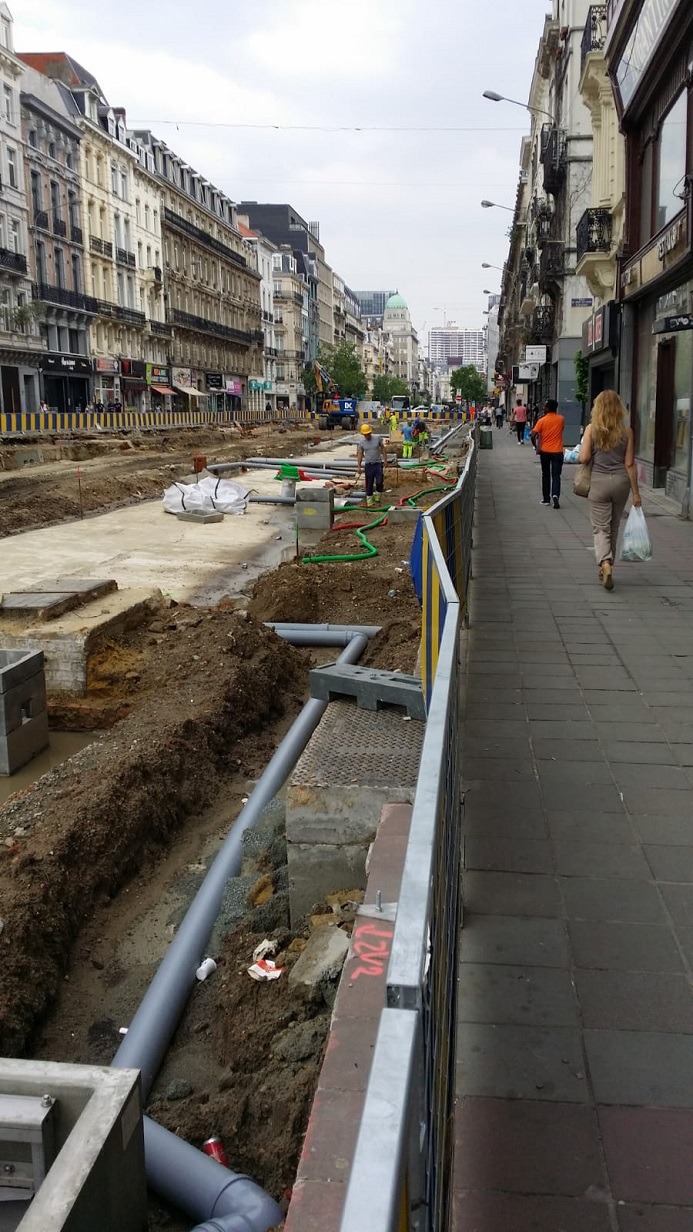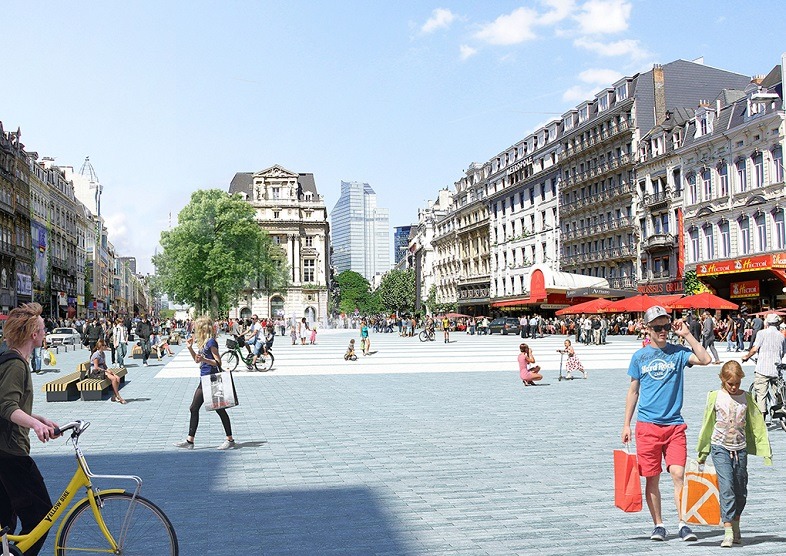Get on with it. That is the blunt message from Brussels’ business community to the various authorities overseeing the city’s huge pedestrian project. The works were due to have been completed by autumn 2018 but, according to a key advisor to the Brussels Enterprises Commerce and Industry (BECI), the body that represents the interests of the city’s business world, this target is now highly unlikely to be met. It is more likely to be next year – or even 2020 – before the showpiece scheme is finally finished.
First a reminder: the ambitious project aims to turn part of the city centre into a car-free zone with comparisons made with Las Ramblas, the famous pedestrian-friendly thoroughfare in Barcelona. But while thousands flock to the delightful Catalan street, the Brussels version currently resembles more of a mini war zone with some shopkeepers complaining about loss of trade and accessibility problems.
Certainly, the scheme, first mooted in 2014, has had its difficulties, most recently with the new paving stones on boulevard Anspach being laid the wrong way round. That was a relatively minor issue and quickly remedied. But other problems are proving more difficult to fix. These principally revolve around the assertion that the scheme has fallen way behind schedule.
Ischa Lambrechts, an adviser on mobility/transport issues to BECI, points out that the idea was for everything to be completed by later this year. “This is now very unlikely and it’s more likely to be either 2019 or 2020,” he told The Brussels Times. Even so, Pascal Smet, Brussels Minister of Mobility and Public Works, insists that notwithstanding some delays the works are “in full swing”.
Mixed news
So far, the story that has emerged appears to be a mixture of good and bad news. The bad news, for example, is that some businesses, complaining of lack of trade caused by the extensive pedestrian works, have either closed shop or relocated to other areas. One businessman, who runs a small gift shop in the area, said he had suffered a “big drop” in trade since the scheme started and was “seriously thinking” of closing. He said, “I don’t know if it’s just the pedestrianisation scheme that’s to blame but my revenue is certainly well down since it all started.”

Work in the city centre has been dragging out for longer than expected with mixed feelings by Brussels locals. There is still a long way to go, and the original target to complete everything by autumn 2018 has been postponed to 2019 and maybe even 2020.
The council said any dip in business is not due to the works but to “changes in mobility” caused by the zone. Lambrechts argues that other factors could also have contributed, saying, “You also need to take into account the closure of some of the tunnels in Brussels and the Brussels lockdown.” This is a reference to the fact that the government of Belgium imposed a security lockdown on Brussels, including the closure of shops, schools and public transportation following the terrorist attacks on 22 March 2016.
However, since the current programme got underway, the leading furniture store Maisons du Monde decided to vacate its prime position at the heart of the new car-free zone. That apparently negative news is offset by the fact that Dutch-language bookstore Standaard Boekhandel is leaving its place de la Monnaie location to move into a new location on the pedestrian zone – the one previously occupied by Maisons du Monde. The bookstore says the move, due to go ahead in June, will allow it to double in size.
Another example is Burger King, which plans to open its first central Brussels restaurant in the new Crystal City commercial development on Boulevard Anspach at De Brouckere (taking over the premises of Mexican restaurant Chi-Chi's). Crystal City is the new name for the Gretry Building and will accommodate shops, offices and housing. Burger King wanted to open in June but a spokesman said the move is now not likely until the autumn, adding, "The pedestrian zone works and the time taken to grant permits means we now hope to open around November."
Value for money
Of course, there was already a pedestrian zone in the centre – around Grand Place – but the current scheme foresees an extension of the existing zone from 28 acres to 50 acres. The total cost of the zone is now €34.6 million, with an estimated €9.3m on renovation of the Bourse Metro station and a further €11m being spent on renovation of the De Brouckere station near place de la Monnaie. An additional €1.6m has been set aside to speed up the work before October, in particular between place Fontainas and rue des Riches Claires. The financing of the scheme is based on a cooperation agreement between the federal government and the government of the Brussels Capital Region.
Asbestos has been removed, additional CCTV cameras installed and new entrances constructed. Artwork at the stations is also being improved with the introduction of works of art by Paul Bury and Paul Delvaux. And as part of plans to make the area more friendly and green, no less than 84 new trees will also be planted.
De Brouckere station is due for completion by the autumn (the Bourse by the end of 2018) and the whole idea, says Smet, is to make the stations “safer and cleaner”. The plans include underground bike parking with an estimated capacity of 1,250 cycles. Under the Belgian Highway Code, it is not permitted to build cycle lanes in a pedestrian zone. Ischa Lambrechts points out that a pedestrian zone is built from façade to façade, so cycle lanes are not allowed. Cyclists will be allowed in the zone but subject to a maximum speed of 5km. “Cyclists will need to walk if they could endanger pedestrians,” he says.

Visualisation of what the pedestrian zone aims to look like once work is complete. © Ville De Bruxelles/Stad Brussel
Smet says the work will “completely transform” both metro stations and stresses that throughout the work both will remain open to the travelling public. "By investing in quality public transport, we are investing in better quality of life and better air quality for people in Brussels. Thus, Brussels once again takes a major step in the transformation of a city for cars to a city for everyone,” he said.
Brussels Alderwoman Els Ampe told The Brussels Times that the renovation is “considerable”, adding, “A small part of the Brussels pedestrian zone is now open for visitors. I’m so pleased we can finally show what our pedestrian zone will look like once completely finished. There will be ten times more green spaces and trees than before”.
Ampe, Alderwoman in charge of Public Works in the City of Brussels, said, “Sixty five percent of all road works needed to complete the pedestrian zone are done, most of it under the ground. All electricity and gas cables, the sewage system and internet cables have been renewed. “Now new green spaces and trees are planted and pavement works are executed. The works are now done in double shifts. Workers have also been busy during the weekends,” she said.
Several rules will apply in the pedestrian zone, including a ban on the parking of cars and discharging of goods deliveries (only permitted between 4 am and 11 am).
So as to enable citizens and users to “enjoy a greener, more liveable and pleasant city centre as quickly as possible” the City of Brussels has tried to speed up the project by extending the working hours. Until now, work was only allowed between 7am to 4pm on weekdays but is now 6am to 6pm and on weekends too. Contractors are being also urged “to do everything possible to limit any inconvenience,” said a source in City of Brussels.
To follow the pedestrianisation project in detail you can visit www.centreville.bruxelles.be, where news is regularly published.
By Martin Banks

